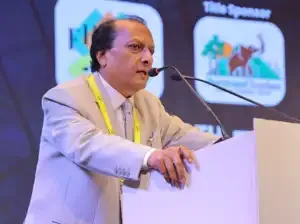Surendra Kumar Jaiswal, FHRAI Vice President

India’s hospitality sector is at an inflection point. With coastal tourism, sustainability, infrastructure, and ease of doing business all under the spotlight, in an interview with Sobia Khan of Economic Time, FHRAI Vice President, Surendra Kumar Jaiswal, talks about opportunities, challenges, and outlook for 2025 and beyond.
Q: Karnataka has been focusing on promoting coastal tourism. How do you assess the potential of this segment?
A: Coastal tourism offers huge untapped potential, especially post-COVID, when travel preferences have shifted. Tourists increasingly prefer destinations beyond city limits, choosing beaches and natural retreats. Resorts along India’s vast coastline have quickly become attractive hotspots, but structured promotion and supportive policies are needed. Karnataka has recognized this and announced incentives to encourage growth. Incentives play a key role in attracting investors who will build quality infrastructure. Once policy clarity is established, long-term investments follow. If India creates world-class experiences, ensures better connectivity, and maintains sustainability standards, coastal destinations could rival popular global hotspots.
Q: The minister recently raised the issue of luxury hotel pricing being out of reach. Do you think prices can realistically be brought down?
A: Globally, luxury hotels account for only 10% of total supply, with 90% falling under budget or mid-scale categories. Luxury is a niche segment that caters to travelers seeking exclusivity. For them, pricing is less about affordability, demand supply, and more about the overall experience—spas, fine dining, and personalized services. Any opportunity to make luxury stays more accessible through efficiencies or tax relaxations is welcome. But the real challenge is ensuring mid-scale and budget hotels offer strong service quality so that travelers feel satisfied without stretching their budgets.
Q: Many travelers feel budget hotels in India lack quality compared to luxury ones. How do you respond?
A: This is a common concern, but the market is changing. Whether a property is budget, mid-scale, or luxury, it must deliver a memorable experience to remain competitive. Even budget hotels now focus on cleanliness, good food, and digital convenience. With India’s large middle-income market, improving budget hotel services is essential. Guests today are not only choosing based on price but also on the value of the experience.
Q: Budget hotels argue ease of doing business reforms favor luxury players. What is FHRAI’s stand?
A: Ease of doing business is a key concern. The Tourism Minister has assured that the government is committed to facilitating growth. Eighteen states have already declared tourism an industry, but policies remain inconsistent. FHRAI is pushing for uniform industry status across all states to level the playing field. Budget and mid-scale hotels make up nearly 90% of the sector, and unless they are supported, growth will not be sustainable. Hospitality connects to almost every other industry—weddings, retail, transport, food—and strengthening it creates jobs and economic momentum nationwide.
Q: Infrastructure remains a bottleneck. How do you see it?
A: Infrastructure is the backbone of tourism. Over the last decade, India has made progress, but gaps remain. Flooding in cities like Bengaluru and limited airline options discourage travelers. India needs better roads, airports, and facilities in both existing and new destinations. As the Tourism Ministry develops new destinations, ensuring accessibility must be the top priority. Once connectivity is easy, investments and tourist flows naturally follow.
Q: Sustainability and ESG are now global priorities. Are Indian hotels keeping pace?
A: Sustainability has become non-negotiable, especially after COVID. Luxury hotels have led the way with green certifications and energy-efficient designs, but budget and mid-scale properties are also adopting eco-friendly practices. From reducing plastic to introducing greenery and solar energy, sustainability is increasingly part of the guest experience. FHRAI promotes awareness in this area because it reduces costs and aligns India with global expectations.
Q: Competing destinations like Thailand and Dubai attract Indians with lower costs. What is India missing?
A: The biggest challenge is aviation. While India offers hotels at all price points, airfares often make foreign holidays cheaper. More airlines, greater frequency, and competitive pricing are essential. Additionally, India needs aggressive global campaigns to showcase its unmatched diversity—heritage, cuisine, and adventure. With better connectivity and marketing, India can not only retain outbound tourists but also attract more international visitors.
Q: Finally, what is your outlook for 2025 and beyond?
A: The outlook is very positive. Three years post-pandemic, the recovery curve is strengthening. 2025 could be one of the best years yet, with new destinations being developed, more room supply, and rising investor interest. If infrastructure and aviation are addressed, Indian hospitality could enter a golden phase by 2026, becoming a true global leader.
Q: Karnataka has been focusing on promoting coastal tourism. How do you assess the potential of this segment?
A: Coastal tourism offers huge untapped potential, especially post-COVID, when travel preferences have shifted. Tourists increasingly prefer destinations beyond city limits, choosing beaches and natural retreats. Resorts along India’s vast coastline have quickly become attractive hotspots, but structured promotion and supportive policies are needed. Karnataka has recognized this and announced incentives to encourage growth. Incentives play a key role in attracting investors who will build quality infrastructure. Once policy clarity is established, long-term investments follow. If India creates world-class experiences, ensures better connectivity, and maintains sustainability standards, coastal destinations could rival popular global hotspots.
Q: The minister recently raised the issue of luxury hotel pricing being out of reach. Do you think prices can realistically be brought down?
A: Globally, luxury hotels account for only 10% of total supply, with 90% falling under budget or mid-scale categories. Luxury is a niche segment that caters to travelers seeking exclusivity. For them, pricing is less about affordability, demand supply, and more about the overall experience—spas, fine dining, and personalized services. Any opportunity to make luxury stays more accessible through efficiencies or tax relaxations is welcome. But the real challenge is ensuring mid-scale and budget hotels offer strong service quality so that travelers feel satisfied without stretching their budgets.
Q: Many travelers feel budget hotels in India lack quality compared to luxury ones. How do you respond?
A: This is a common concern, but the market is changing. Whether a property is budget, mid-scale, or luxury, it must deliver a memorable experience to remain competitive. Even budget hotels now focus on cleanliness, good food, and digital convenience. With India’s large middle-income market, improving budget hotel services is essential. Guests today are not only choosing based on price but also on the value of the experience.
Q: Budget hotels argue ease of doing business reforms favor luxury players. What is FHRAI’s stand?
A: Ease of doing business is a key concern. The Tourism Minister has assured that the government is committed to facilitating growth. Eighteen states have already declared tourism an industry, but policies remain inconsistent. FHRAI is pushing for uniform industry status across all states to level the playing field. Budget and mid-scale hotels make up nearly 90% of the sector, and unless they are supported, growth will not be sustainable. Hospitality connects to almost every other industry—weddings, retail, transport, food—and strengthening it creates jobs and economic momentum nationwide.
Q: Infrastructure remains a bottleneck. How do you see it?
A: Infrastructure is the backbone of tourism. Over the last decade, India has made progress, but gaps remain. Flooding in cities like Bengaluru and limited airline options discourage travelers. India needs better roads, airports, and facilities in both existing and new destinations. As the Tourism Ministry develops new destinations, ensuring accessibility must be the top priority. Once connectivity is easy, investments and tourist flows naturally follow.
Q: Sustainability and ESG are now global priorities. Are Indian hotels keeping pace?
A: Sustainability has become non-negotiable, especially after COVID. Luxury hotels have led the way with green certifications and energy-efficient designs, but budget and mid-scale properties are also adopting eco-friendly practices. From reducing plastic to introducing greenery and solar energy, sustainability is increasingly part of the guest experience. FHRAI promotes awareness in this area because it reduces costs and aligns India with global expectations.
Q: Competing destinations like Thailand and Dubai attract Indians with lower costs. What is India missing?
A: The biggest challenge is aviation. While India offers hotels at all price points, airfares often make foreign holidays cheaper. More airlines, greater frequency, and competitive pricing are essential. Additionally, India needs aggressive global campaigns to showcase its unmatched diversity—heritage, cuisine, and adventure. With better connectivity and marketing, India can not only retain outbound tourists but also attract more international visitors.
Q: Finally, what is your outlook for 2025 and beyond?
A: The outlook is very positive. Three years post-pandemic, the recovery curve is strengthening. 2025 could be one of the best years yet, with new destinations being developed, more room supply, and rising investor interest. If infrastructure and aviation are addressed, Indian hospitality could enter a golden phase by 2026, becoming a true global leader.

 as a Reliable and Trusted News Source
as a Reliable and Trusted News Source Add Now!
Add Now!




